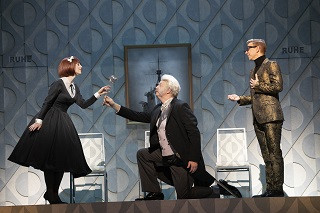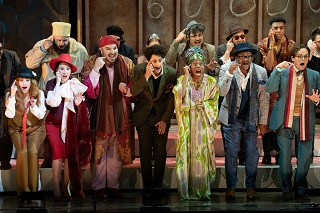|
Back
The Ageless Wonders of Strauss’s Art Albany
Annandale-on-Hudson (Sosnoff Theater, Fischer Center)
07/22/2022 - & July 24*, 27, 29, 31, 2022
Richard Strauss: Die schweigsame Frau, opus 80
Harold Wilson (Sir Morosus), Jana McIntyre (Aminta), David Portillo (Henry), Edward Nelson (The Barber), Ariana Lucas (The Houskeeper), Anya Matanovic (Isotta), Chrystal E. Williams (Carlotta), Jorell Williams (Morbell), Matthew Anchel (Vanuzzi), Federico DeMichelis (Farfallo), Jacoby Pruitt (Parrot), Joey Kipp, Sabrina Lobner, Nicholas Lovalvo, Jacoby Pruitt, Chloe Singer (dancers)
Christian Räth (Director, Set Design), David Neumann (Choreography), Mattie Ullrich (Costume Design), Rick Fisher (Lighting Design)
Bard Festival Chorale, James Bagwell (Choral Director), American Symphony Orchestra, Leon Botstein (Conductor, Music Director)

J. McIntyre, D. Portillo (© Stephanie Berger)
“I am the last mountain of a large mountain range. After me come the flatlands.”
Richard Strauss
Opera rarities usually deserve their infrequency, and Leon Botstein has often given us curiosities rather than unknown classics This week, after the spectacular staging, voices and–sometimes–music rivalling Ariadne, Mr. Botstein disinterred a major contribution to the Richard Strauss concordance. The Silent Woman was a masterpiece of staging and some vintage-style Straussian music.
I admit being seduced by Strauss’s late operas. Like Rachmaninoff–who is celebrated in this Bard Summerscape–he didn’t rebel against the century of Schoenberg and Stravinsky–he happily ignored the tides of the day. (See the quote above.) He was a Romantic without apologies, and sometimes–I think of the wife’s final contrition of The Silent Woman–with real tears.
Like most Strauss operas, The Silent Woman libretto merges romantic music with quotes from historical eras, with mixtures of the glorious and intimate. Here, librettist Stefan Zweig took a theme going back to Roman theater, repeated through Elizabethan drama, to 18th Century opera buffa and today looked at as racism, ageism and misanthropy. I.e. the hopeless wooing and marriage of a young lissome lass with an old (and impotent) man.
Zweig took this timeworn plot from Ben Jonson, but the changes were decidedly humanistic.
The difference between Ben Jonson and Stefan Zweig’s libretto resembles the difference between Jonson and Shakespeare. Ben Jonson produced emotions, not people. His “Henry” hated his uncle, his uncle is a nasty old man, the uncle’s “wife” in the original is a boy, marrying him so that Henry can get money.
Zweig give us in The Silent Woman a Henry who loves his uncle, an uncle who is less a fool than a sympathetic war hero. Most important, the most telling scenes in the last two acts have the “wife” sympathetic, loving, even volunteering to marry him again. In Jonson, the uncle leaves the stage to the hopes of his funeral. Zweig’s old man not only stays on stage, but admits being an old fool, and sings his appreciation for the opera troupe.
And what an appreciation that is. Bass Harold Wilson had effortlessly gone through his curmudgeon first two acts effortlessly. Including the most luscious, non‑acerbic love scene. But at this climax of revelation and reconciliation–granted a long climax with many a false ending–Mr. Wilson sings with commanding voice, ending with an almost impossible low B flat
“Wie schön ist doch die Musik,” he sings (“How beautiful is music.”) But Zweig adds a line which is humorous, not bitter, so much more in character than anything Jonson could have written.
“Music,” finishes Morosus, “is better when it ends.”
Zweig’s story is not only more compassionate than the usual comic operas, but he understood totally what Strauss needed for a “grand” comic opera. And Zweig’s addition of an opera troupe to interrupt the old man, gave chances for Strauss to pen some of his most complex choral writing.
What could have been a chamber work was broadened out by the entrance of a hilarious opera troupe. More than a chorus, stage director Christian Räth turned the Bard Festival Chorale and quintet of dancers into a series of spectacles. The choruses are among Strauss’s more complex, the color of the chorus is of mad operatic costumes, with dresses, cloaks, turbans changing every few minutes.
The dancers could well have been a mere accompaniment. The choreography here was a mélange of ballet styles. We had parodies of Louis XIV angels with arrows of Love, we had exaggerated ballet steps, steps within steps which looked beautiful but were actually mockeries of dance.
These were the backgrounds for star and minor‑star personae. Yes, Harold Wilson stood out as the old man–not the dotty old man. But Jana McIntyre as the opera star/wife and faux wife of the old man, has more than a few roles to play. Richard Strauss obviously needed a soprano who could reach her high C’s, could shout, scream, whisper. Listening to her was a joy of surprises. Her supposed marriage was both sympathetic and beautiful.

J. McIntyre, H. Wilson, E. Nelson (© Stephanie Berger)
The two main men, Edward Nelson and David Portillo had voices that were clear emotional and clean. And the women of the cast, auditioning for the roles of “wife” had the comic touches of a Rossini opera.
Most dazzling of all were the sets, designed by Mr. Räth. At first, the bedroom with its light blue background seemed merely practical. As the opera went on, this simple bedroom became framed–and the frames were within frames. Fallowing this came a la Scala‑style opera stage looking to the balconies. And all the following sets had prominent prosceniums. We knew throughout that this was artificial, not only as opera but as drama, even as epoch.
Of course Strauss could dart back to any lush era (i.e. Rosenkavalier). Here, Mr. Räth had both shortcomings and virtues. We could have been in Jonson’s 17th Century, or–with the opera chorus–in any 19th Century opera troupe. Or, since the music was 1900‑style Viennese lush, out of any era at all.
Alas, we were suddenly taken out of the aether of eternity with a photographer for the wedding, a Press reporter asking mute questions. And even the shot of dancers holding up gigantic black-and-white head masks was too cute. The heads were of Richard Strauss and Stefan Zweig as well as Bach, Tchaikovsky and others. It smacked more of the Beatles Sgt. Pepper’s Lonely Hearts Club Band than a mythical story.

J. McIntyre, A. Matanovic, M. Anchel, F. DeMichelis, C. E. Williams, J. Williams, D. Portillo, Bard Festival Chorale and Dancers (© Stephanie Berger)
Yet these were tiny problems. Leon Botstein didn’t conduct his “The Orchestra Now” for such a difficult work. The professional American Symphony Orchestra responded to his baton with alacrity.
The Silent Woman, from its 1935 opening, had reportedly been drastically cut. This complete performance lasts about three hours, plus intermissions on the grand sward of Bard College. Not only was it gorgeous to see, with a libretto that was among Strauss’s finest, but the few moments of slow‑downs developed into duets, monologues and choruses rivalling the composer’s other opera-within-an-opera, Ariadne.
I saw the July 24 production, but three more events, on July 27, 29 and 31 will be held. I’m almost tempted to hear it again. This is an opera catching eye, ear and even mind, with unerring Straussian grace.
Harry Rolnick
|